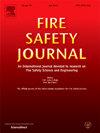Experimental observation of the quenching distance of flames propagating in a closed duct at different velocities and with different Lewis and Zeldovich numbers
IF 3.3
3区 工程技术
Q2 ENGINEERING, CIVIL
引用次数: 0
Abstract
Investigation of the quenching distance is important for the design of flame arresters. The quenching process is related to the coupled effects of heat and mass transfer in reactive flows. The aim of this work is to experimentally determine the quenching distance of flames propagating in a closed duct. The mixtures involve natural gas, hydrogen, helium and air to obtain Lewis and Zeldovich numbers from 0.6 to 1.36 and from 4.24 to 8.45, respectively. In addition, obstacles were placed inside the duct to evaluate the effect of flame propagation velocity on the quenching distance via the Peclet number. The quenching distance was measured as the distance between two horizontal plates that does not allow the flame to continue propagating. The results show that mixtures with Lewis numbers less than one and low values of Zeldovich have the smallest quenching distances. Conversely, mixtures with Lewis numbers greater than one or high Zeldovich values have higher quenching distances. When mass diffusion dominates over heat diffusion, the flame temperature is higher. In addition, the negative exponential dependence of the heat release is controlled by the Zeldovich number. This explains the experimental results. In the experiments where the flame velocity was increased by obstacles, the mixtures with high Zeldovich number increased their quenching distance, whereas the opposite was observed for mixtures with low Zeldovich. The Peclet numbers determined show that advection dominates over heat diffusion. The critical Peclet numbers calculated on the basis of laminar flame velocity were always less than 35.
不同速度、不同Lewis数和Zeldovich数下火焰在密闭管道中熄灭距离的实验观察
淬火距离的研究对阻火器的设计具有重要意义。淬火过程与反应流中传热传质耦合作用有关。本工作的目的是通过实验确定火焰在封闭管道中传播的淬火距离。将天然气、氢气、氦气和空气混合,分别得到0.6 ~ 1.36和4.24 ~ 8.45的Lewis数和Zeldovich数。此外,在管道内放置障碍物,通过Peclet数评估火焰传播速度对淬火距离的影响。淬火距离测量为两个水平板之间不允许火焰继续传播的距离。结果表明,刘易斯数小于1且Zeldovich值较低的混合物具有最小的淬火距离。相反,刘易斯数大于1或Zeldovich值较高的混合物具有较高的淬火距离。当质量扩散大于热扩散时,火焰温度较高。此外,热释放的负指数依赖关系由Zeldovich数控制。这就解释了实验结果。在障碍物增加火焰速度的实验中,高泽尔多维奇数的混合物的熄灭距离增加,而低泽尔多维奇数的混合物的熄灭距离相反。确定的佩莱特数表明平流在热扩散中占主导地位。基于层流火焰速度计算的临界佩莱特数总是小于35。
本文章由计算机程序翻译,如有差异,请以英文原文为准。
求助全文
约1分钟内获得全文
求助全文
来源期刊

Fire Safety Journal
工程技术-材料科学:综合
CiteScore
5.70
自引率
9.70%
发文量
153
审稿时长
60 days
期刊介绍:
Fire Safety Journal is the leading publication dealing with all aspects of fire safety engineering. Its scope is purposefully wide, as it is deemed important to encourage papers from all sources within this multidisciplinary subject, thus providing a forum for its further development as a distinct engineering discipline. This is an essential step towards gaining a status equal to that enjoyed by the other engineering disciplines.
 求助内容:
求助内容: 应助结果提醒方式:
应助结果提醒方式:


